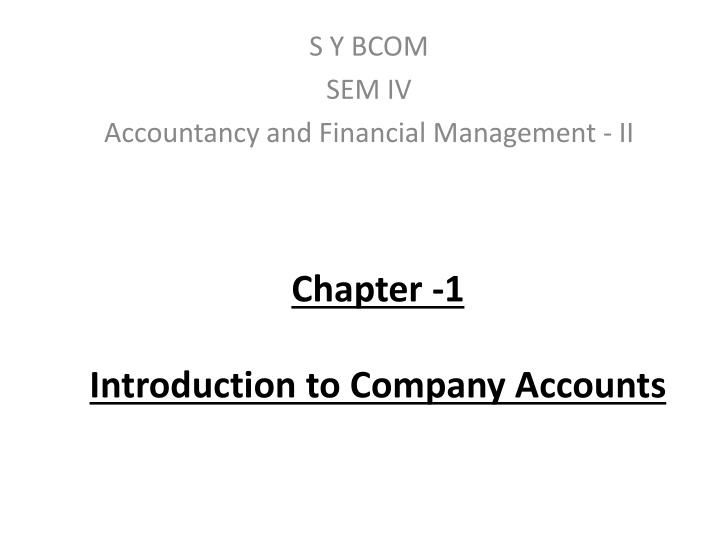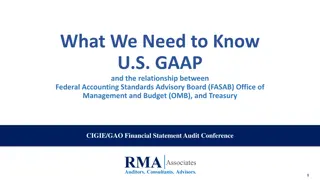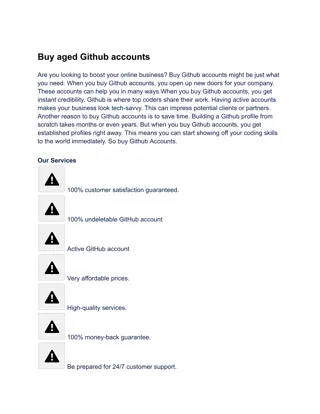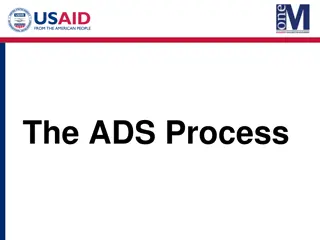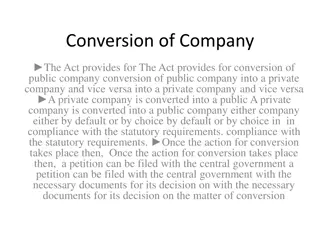Overview of Company Accounts and Share Issuance
This chapter introduces fundamental concepts related to company accounts, including types of companies, share capital, reserves, debentures, and more. It covers topics like share issuance methods, debenture types, and membership structures of companies. Understanding these concepts is crucial for grasping the financial management aspect of businesses.
Download Presentation

Please find below an Image/Link to download the presentation.
The content on the website is provided AS IS for your information and personal use only. It may not be sold, licensed, or shared on other websites without obtaining consent from the author.If you encounter any issues during the download, it is possible that the publisher has removed the file from their server.
You are allowed to download the files provided on this website for personal or commercial use, subject to the condition that they are used lawfully. All files are the property of their respective owners.
The content on the website is provided AS IS for your information and personal use only. It may not be sold, licensed, or shared on other websites without obtaining consent from the author.
E N D
Presentation Transcript
S Y BCOM SEM IV Accountancy and Financial Management - II Chapter -1 Introduction to Company Accounts
Topics to be covered Introduction of basic terms: Types of companies, nature and formation of companies, Shares, Debentures, Share Capital, Reserves and surplus, Types of assets and liabilities, dividend, Format of Balance Sheet (Only theory) Issue of shares: Different modes IPO, Private Placements, Preferential, Rights, ESO, SWEAT and ESCROW account, Issue of shares at par, premium and discount,
Topics to be covered Under subscription and Over subscription of shares Forfeiture and reissue of forfeited shares Issue of shares for consideration other than cash. (Only theory) Issue of Debentures: types of Debentures, Issue of debentures at par, premium and discount, Issue of Debentures with consideration of Redemption, Issue of debentures for cash receivable in installments or at a time Issue of debentures for consideration other than cash. (Only theory)
Types of Companies On the Basis of Registration Registered Companies Chartered Companies Statutory Companies The Companies registered under Special Act of Central or State Legislature are called Statutory Companies. E.g. RBI, LIC, UTI. The Companies registered under the Companies Act 2013 or under any earlier Companies Act are known as Registered Companies E.g. Tata Steel, Godrej. The Companies which are registered under the Special Charter granted by king or queen of England are known as Charter Companies. E.g. East India Company. Such companies are no longer in existence in India.
On the Basis of Number of Members Private Companies Public Companies One Person Companies A Private Company is one which has 2 to 200 members. It cannot invite members of Public to subscribe its securities and its securities are not freely transferable, there are restrictions on transfer. A Public Company is one which has 7 to unlimited number of members and the securities of which are freely transferable without any restrictions. The concept of One Person Company is introduced by the Companies Act 2013. It is a Company which has only one person as its member.
On the Basis of Liability of Members Companies Limited by Shares Companies Limited by Guarantee Companies with Unlimited Liability A Company Limited by Shares is where the Shareholder is liable only for the unpaid amount on the shares purchased by him. A Company Limited by Guarantee is where the Memorandum of Association (MOA) specifies the fixed amount beyond which the member will not be liable to contribute in case of liquidation. A Company with Unlimited Liability is where the MOA does not have any provision limiting the liability of its members. The liability of its members is similar to that of the partners in a firm.
On the Basis of Listing Listed Companies Unlisted Companies A Listed Company is one whose Shares are on the Stock Exchange such as National Stock Exchange (NSE) or Bombay Stock Exchange (BSE). An Unlisted Company is one whose shares are not listed on the Stock Exchange
Other Types of Companies Associate Companies Foreign Companies Small Companies Government Companies Non-Profit Companies Holding & Subsidiary Companies Illegal Producer Companies Associations
Formation of Companies Four Stages I. Promotion of the Company II. Incorporation of a Company III. Commencement of Business IV. Share Capital
Means of funding Share Capital Types of Share Capital - Preference Shares - Ordinary or Equity Shares Debentures
Preference Shares Preference shares are entitled to a fixed percentage of dividends before any ordinary dividends are paid They usually do not have voting rights The different types of preference shares are: Cumulative preference shares Non-cumulative preference shares
Types of Preference Shares Cumulative preference shares Any unpaid dividends on cumulative preference shares can be carried forward to a later year. Non-cumulative preference shares If the profits are insufficient to pay the dividends, the unpaid dividends cannot be carried forward to later years.
Ordinary / Equity Shares The dividends of ordinary shares are not fixed. They depend on the return of the company. Ordinary shareholders are paid only after all other claim (e.g. interest on loan and preference share dividends) have been met. Ordinary shareholders have voting rights. They are the owners of the Company
Debentures Debentures are long-term loans evidenced by deeds. They are entitled to fixed rate of interest. Interest is payable every year. The debentures are to be repaid on the date of redemption. Debenture holders are not the owners of the company but Creditors of the Company.
Reserves They are the accumulated or undistributed profits which have been retained within the company. Reserves are profits or gains which accrue only to the ordinary shareholders. There are two types of reserves: Revenue reserves Capital reserves
Revenue Reserves They are undistributed trading profits i.e. the profits out of the normal business of the Company. They can be used to pay dividends. They are also known as Free Reserves or Divisible Profits E.g. the balance on the profit and loss account and general reserve
Capital Reserves They are gains or profits arising from non-trading or non-operating activities They are know as Non-divisible Profits also They are not available for distribution as dividends E.g. Share premium, revaluation reserve, capital redemption reserve and debenture redemption reserve
S Y BCOM SEM IV Accountancy and Financial Management - II Issue of Shares
Issue of Shares / Debentures Issue of Shares / Debentures can be at Par, Premium or Discount. If the Shares / Debentures are issued at the Face Value itself, it is known as issued at Par. E.g. Rs.10 / 100 If the Shares / Debentures are issued at the price higher than the Face Value/ par, it is known as issued at Premium. This excess amount is called share premium. This is a Capital gain for the Company. E.g. Rs.12 / 120 If the Shares / Debentures are issued at the price lower than the Face Value/ par, it is known as issued at Discount. The deficit amount is called Discount. This is a Capital loss for the Company. E.g. Rs.9 / 90
Under-Subscription Sometimes, the applications for shares received are less than the number of shares issued. For instance, a Company issued 10,000 shares to the public and the Company received applications for 8000 shares from the public. This situation is called Under-subscription. In such cases, the allotment may be done to the number of shares subscribed for i.e. 8,000 shares, which is less than the issued shares. But if the Company fails to receive the minimum subscription, shares cannot be allotted. And all the application money will be returned to the applicants.
Over-Subscription Sometimes, a Company receives applications for a larger number of shares than offered by it to public for subscription. For instance, a Company issued 10,000 shares to the public and the Company received applications for 12,000 shares from the public. This situation is termed as Over- subscription. However, allotment can be made only to the number of shares that are issued. The Company cannot allot more shares than the issued even if there is demand for the shares.
Since share applications have been received along- with application money, it is necessary for the Company to adopt any one of the following methods: (a)Rejection Number of Shares of Applications for Excess (b)Allotment of Shares on Pro-Rata Basis to all (c) (i) Rejections of Some Applications (ii) Allotment to Remaining Applicants on Pro-Rata Basis
Payment on shares While applying for the shares, along with application form, application money is to be paid. On application being accepted, shares are allotted to the applicant and he has to pay the allotment money. And the applicant becomes the shareholder of the company After this, as and when required the Company may ask the shareholder to pay the balance money in form of Call there can be first call & the Final call, first and second call, First, second and final call. This means that the money on share is paid in parts eg. Rs. 3 Application Rs. 30 Application Rs. 2 Allotment Rs. 20 Allotment Rs. 3 First Call Rs. 30 First Call Rs. 2 Final Call Rs. 20 Final Call
Forfeiture of shares If the shareholder fails to pay the allotment money or the call money on his shares as called upon by the company, his shares may be forfeited by giving due notice and following the procedure specified in the articles of Association on this behalf. This is called forfeiture of shares. Effect of forfeiture of shares The effect of the forfeiture is that the shares of the defaulting share holders are cancelled, his name is removed fro the register of members and the amount already paid by him is forfeited.
Capital Structure Authorized Capital It is the maximum amount of share capital which the company is allowed to issue Issued Capital It is the nominal value of a portion of the authorized capital which has been taken up (purchased) by shareholders Called Up Capital It is the amount of issued capital which the company has called to be paid Paid Up Capital It the amount of issued capital which has actually been received Calls in Arrears It the amount of called up capital which has not been received
Reissue of the forfeited shares The directors of the company have the power to re- issue the forfeited shares on such terms as it think fit. The forfeited shares can be reissued at par, or at premium or at discount. However, if the forfeited shares are reissued at discount, the amount of discount should not exceed the amount credited to the share forfeiture A/c. The surplus left in the share forfeited A/c after its reissue will be transferred to the Capital Reserve A/c. as this surplus will be of the nature of capital profits.
Shares issued for Consideration other than cash A company can issue its shares either For Cash or For Consideration other than Cash. As is clear from the term itself, Shares issued for consideration other than cash means when shares of the company are issued to somebody for something which is not cash. It can be issue of shares to a vendor against the purchase of assets or it can be issue of shares against the purchase of the entire business of an enterprise. It can also be an issue of shares to the brokers, underwriters in lieu of their services to the company. In this case shares are not issued to the public in general.
Various modes of Issue of Shares The various modes of issues of shares depend upon who are the perspective investors, purpose of the company like to generate funds or for the benefit of its shareholders. The different types of shares issues in India are as shown in the picture. Let us see them how they differ from each other.
Public Issue Public Issue: When the issue is for the general public and anyone interested in to invest in the company can buy the shares. It can be further of two types as follows: Initial Public Offer (IPO): When an unlisted company wants to go public for the first time, it can be done through Initial Public Offer. Here, the investors bid for the company within a band (generally given by the company). The bidding value depends upon the valuation of the company. IPO helps the company to get listed and generate funds from public. Further Public Offer (FPO): Here the already listed company generate the funds from the public (anyone interested) for few projects, expansion etc.
Rights Issue & Bonus Issue Rights Issue: The listed company issues these securities only to the existing shareholders of its company. It is based on the ratio in which the shareholders are holding number of shares on any fixed date. Generally, the rights issue are on the discounted rate and are beneficial for the shareholders. So, they prefer to invest in the Right Shares. Bonus Issue: These shares are given to the existing shareholders only, without any consideration from them. These are issued on a fixed date based on the ratio to the number on shares held by the shareholder.
PrivatePlacement Private Placement: Here the company issues the securities to the selected group of investors not exceeding more than 49. It can be done in two ways : Preferential Issue: The listed company issues the equity shares which have some more benefits over the normal equity shares like in terms of dividends etc. These benefits are mentioned at the time of issue. These are done as per Chapter XIII of SEBI (DIP) guidelines. Qualified Institutional Placement (QIP):Here, the listed company issues equity shares or shares convertible into equity shares to Qualified Institutional Buyers only as per Chapter XIIIA of SEBI (DIP) guidelines.
Employee Stock Option Plan (ESOPs) These are a special kind of stock options which are issued only to the employees of the company. The shares are issued at a discounted price and many have cash benefits also. This is done to develop the interest of the employees as the stakeholders of the company for its well being. This plan have the tax benefits for the employees. And the employee can hold the shares only till retirement or till the person is employee of the company.
Sweat Equity Shares These are the equity shares issued by a company to its employees or directors at a discount or for consideration other than cash for providing know- how or making available rights in the nature of intellectual property rights or value additions, by whatever name called. Issue of sweat equity shares to be authorized by special resolution at a general meeting.
Escrow Account Escrow is a legal concept in which a financial instrument or an asset is held by a third party on behalf of two other parties that are in the process of completing a transaction. The funds or assets are held by the escrow agent until it receives the appropriate instructions or until predetermined contractual obligations have been fulfilled. Money, securities, funds, and other assets can all be held in escrow. Stocks, especially those of public companies, are often issued in escrow. This means that while the shareholder is the real owner of the stock, he has limited rights to dispose it off . For example, executives who receive stock as a bonus to their compensation often have to wait for an escrow period to pass before they can sell the stock. This is used as a tactic to retain top executives and protects the stock's market price.
S Y BCOM SEM IV Accountancy and Financial Management - II Issue of Debentures
Topics to be covered Issue of Debentures Types of Debentures Issue of debentures at par, premium and discount Issue of Debentures with consideration of Redemption Issue of debentures for cash receivable in installments or at a time Issue of debentures for consideration other than cash. (Only theory)
Issue of Debentures Debentures are issued in the same manner in which shares are issued. The company issues a prospectus inviting applications along with a sum of money called application money. After scrutiny, the Board of Directors makes allotment of debentures. If the entire sum of money has not been asked for along with applications another sum of money called, allotment money may be asked for. Subsequently there may be a few calls even. But mostly, the entire amount is received on application or on application and allotment.
It is usual to prefix Debentures with the rate of interest. Thus, if the rate of interest is 14 per cent, the name given will be 14% Debentures . Like shares, debentures may be issued at par, at a premium or at a discount. The law does not lay down any maximum limit for discount on issue of debentures. The sanction of the Company Law Board is also not needed. Debentures are invariably redeemable. They may be redeemable at par or at a premium. Redemption of debentures at a premium means that the company pays to the debenture-holders, at the time of redemption, a sum higher than the face value of debentures held by them.
Types Of Debentures On The Basis Of Security a. Secured Or Mortgage Debentures These are the debentures that are secured by a charge on the assets of the company. These are also called mortgage debentures. The holders of secured debentures have the right to recover their principal amount with the unpaid amount of interest on such debentures out of the assets mortgaged by the company. b. Unsecured Debentures Debentures which do not carry any security with regard to the principal amount or unpaid interest are unsecured debentures. These are also called simple debentures.
On The Basis Of Convertibility a. Convertible debentures are bonds that can convert into equity shares of the issuing corporation after a specific period of time. These types of bonds are the most attractive to investors because of the ability to convert, and they are most attractive to companies because of the low interest rate. b. Non-convertible debentures are regular debentures that cannot be converted into equity of the issuing corporation. To compensate, investors are rewarded with a higher interest rate when compared to convertible debentures.
On The Basis Of Redemption a. Redeemable Debentures These are the debentures which are issued for a fixed period. The principal amount of such debentures is paid off to the holders on the expiry of such period. These debentures can be redeemed by annual drawings or by purchasing from the open market. b. Non-redeemable Debentures These are the debentures which are not redeemed in the life time of the company. Such debentures are paid back only when the company goes to liquidation.
On The Basis Of Record Point Of View a. Registered Debentures These are the debentures that are registered with the company. The amount of such debentures is payable only to those debenture holders whose name appears in the register of the company. b. Bearer Debentures These are the debentures which are not recorded in a register of the company. Such debentures are transferable merely by delivery. Holder of bearer debentures is entitled to get the interest.
Issue of Debenture The debentures may be issued: (i) At par (ii) At a premium (iii) At a discount (i) Issue of Debentures at Par: Debentures are said to be issued at par when the amount collected for it is equal to the nominal value (face value) of the debentures; for example, issue of Rs. 1,000 debenture for Rs. 1,000.
(ii) Issue of Debentures at Discount: When debentures are issued by company at a price less than its nominal value (face value) it is said to be issued at discount. It is important to note that the Companies Act has not put any restriction on the maximum limit of discount. For example, if a debenture of Rs. 1,000 is offered to public at Rs. 950, it is issue at a discount. Here Rs. 50 on each debenture is loss to the company. As a principle of equity, it is desirable to write off this loss. Discount is a capital loss and until it is written off- completely, it is shown on the asset side of balance sheet, under the Expenditure , as a fictitious asset. heading Miscellaneous
(iii) Issue of Debentures at Premium: If debentures are issued at a price more than its nominal value (face value) such an issue is called issue at a premium. For example, if a debenture of Rs. 1000 is offered at 1,050, it is a case of issue of debentures at premium. The excess of issue price over face value is premium. The premium is a capital gain for company so it is to be credited to Securities Premium Reserve A/c . The amount of premium on debentures should not be transferred to profit and loss account because it is not a profit arising from the normal operations of the company. Since it is a gain, it is shown on the liabilities side of balance sheet under the head Reserves and Surplus .
Issue of Debentures for consideration other than cash When a company purchases some assets and issues debentures as a payment for the purchase, to the vendors it is known as issue of debentures for consideration other than cash. Such Debentures can be issued to vendors at par, at premium and at discount
ISSUE SECURITY OF DEBENTURES AS COLLATERAL Collateral security means security given in addition to the principal security. It is a subsidiary or secondary security. Whenever a company takes loan from bank or any financial institution it may issue its debentures as secondary security which is in addition to the principal security. Such an issue of debentures is known as issue of debentures as collateral security . The lender will have a right over such debentures only when company fails to pay the loan amount and the principal security is exhausted. In case the need to exercise this right does not arise debentures will be returned back to the company. No interest is paid on the debentures issued as collateral security because company pays interest on loan.
